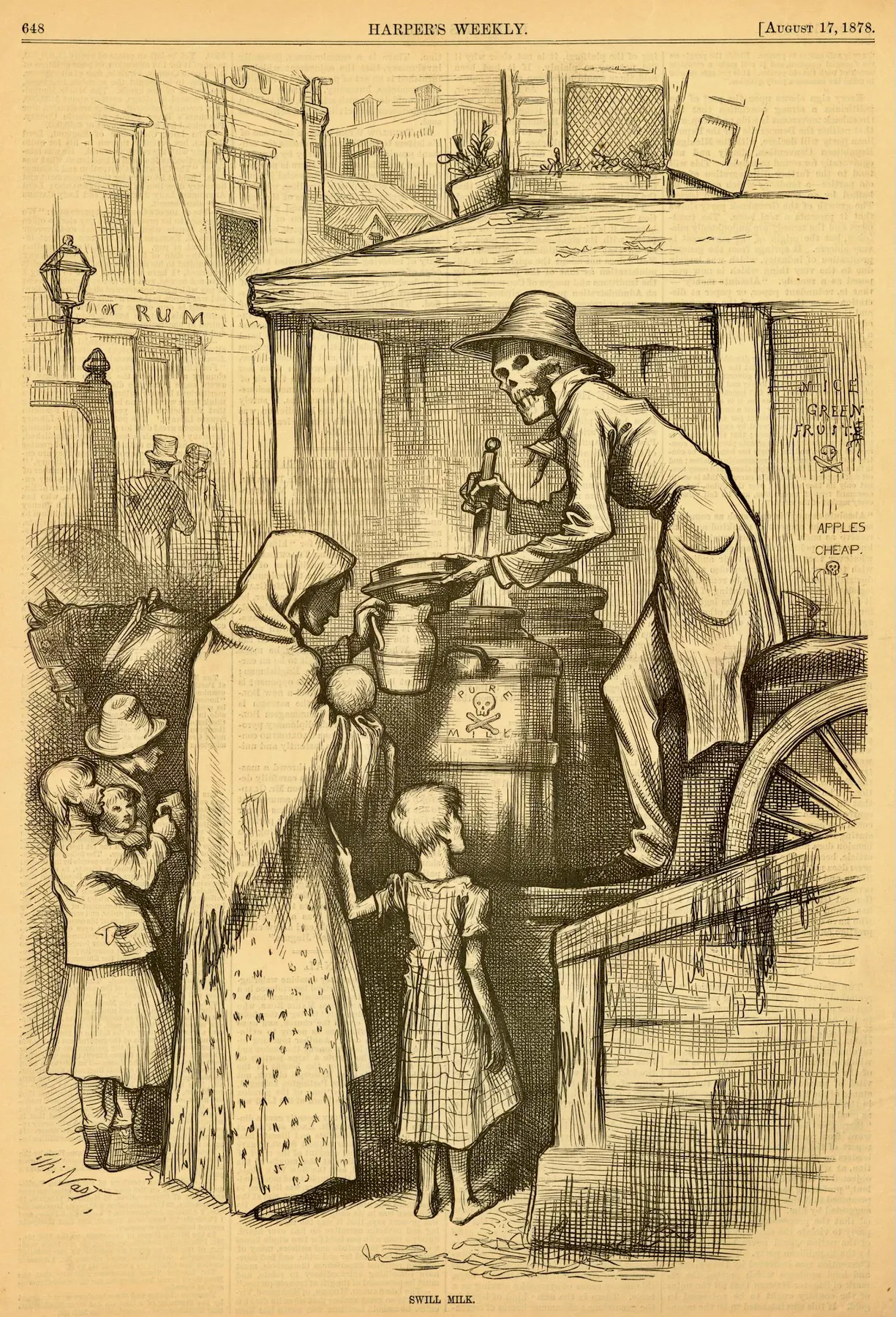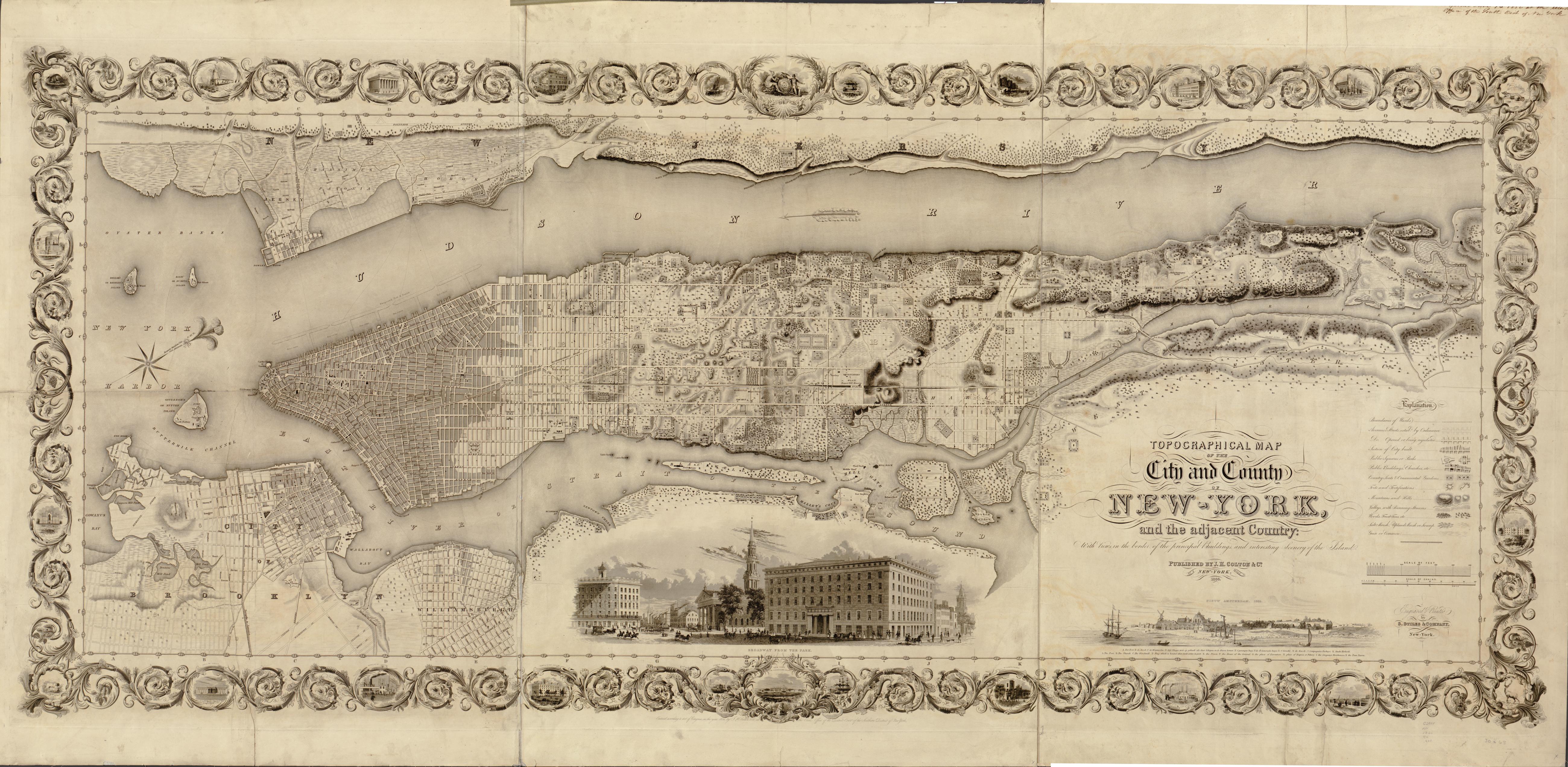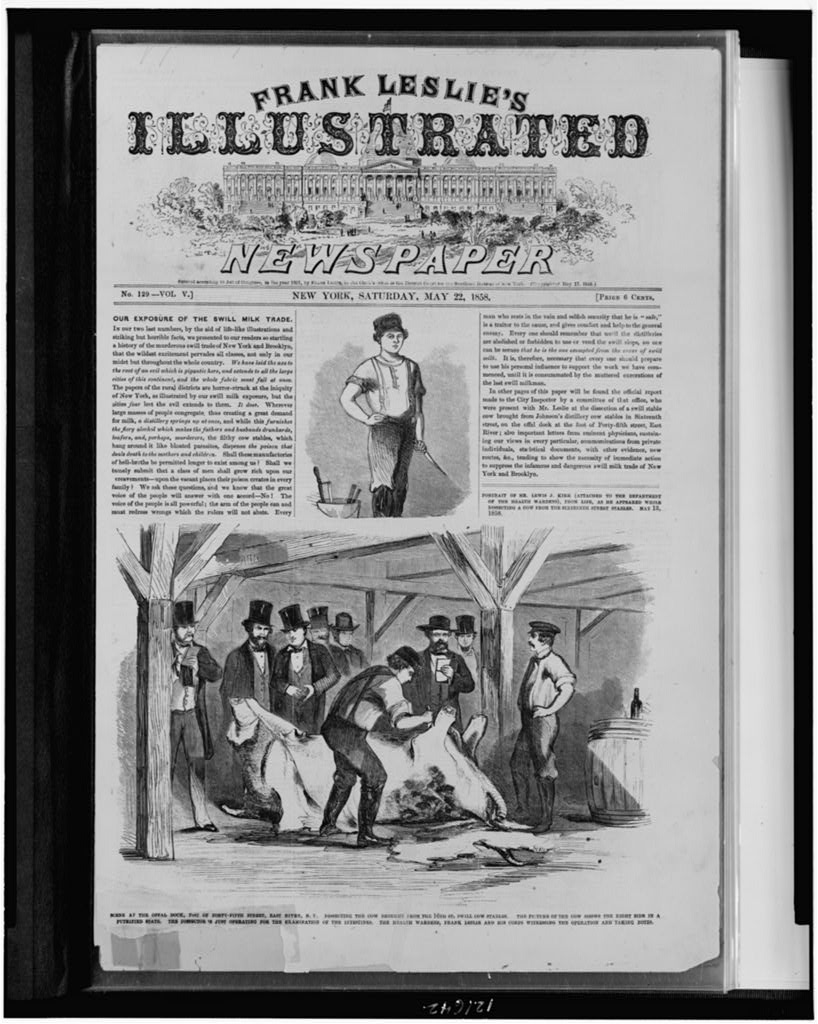This album was created by a member of the TPS Teachers Network, a professional social media network for educators, funded by a grant from the Library of Congress. For more information, visit tpsteachersnetwork.org.
From Swill to Safe: The Fight for Clean Milk in Urban America
Album Description

Swill Milk by Thomas Nast (1878)
This lesson is an adaptation of my post Unpasteurized Plague: RFK Jr. and the Ghosts of Swill Milk. (The post has additional historical background and images.)
In the mid-19th century, America’s cities were booming. Industrialization had sparked rapid urban growth, drawing people from rural areas and overseas into crowded, bustling metropolises like New York. With populations soaring, the demand for basic goods like milk surged. But the infrastructure to supply these cities with fresh, safe food had not kept pace with their growth. Local farmland, once a reliable source of milk, was being paved over for new housing and factories.
This disconnect between urban demand and rural supply created an alarming public health crisis. Dairy farms that once fed on fresh pasture grass were replaced by urban dairies situated next to breweries. These “swill dairies” fed cows on steaming piles of leftover grain mash—a cheap but nutritionally void substitute for proper feed. The result was swill milk: a thin, blue-tinted liquid filled with chalk and chemicals to mask its deficiencies. For many city dwellers, particularly infants, swill milk wasn’t nourishment—it was poison.
Amid this crisis, journalists and reformers began to sound the alarm. Investigative journalism, like the 1858 exposé from Frank Leslie’s Illustrated Weekly, revealed the appalling conditions in swill dairies and pushed the issue into public view. But while outrage helped ignite reforms, it was technology—refrigerated railcars and pasteurization—that ultimately solved the crisis by connecting urban centers to safer, cleaner supplies of milk from rural farms.
This lesson explores the intersection of urbanization, journalism, and technological innovation in solving one of the most deadly food safety crises of the 19th century. Through maps, historical artifacts, and modern comparisons, students will uncover the lessons this history holds for today’s public health challenges.
Introductory Material
1. Begin with a Question:
“Where does your milk come from? How do you think it gets to your fridge safely?”
• Use this to engage students in considering the journey of milk from farm to table.
2. Provide Context on the Swill Milk Crisis:
• Briefly explain the swill milk crisis: Unsanitary urban dairies used industrial waste to feed cows, producing milk that caused widespread disease and infant mortality in the mid-19th century.
• Introduce Frank Leslie’s Illustrated Weekly as an early example of investigative journalism that exposed the issue.
Activity 1: Map Analysis
Objective: To understand the impact of urban growth on local food systems.
1. Distribute copies of the 1836 and 1862 NYC maps.
2. Guided questions for students:
• Identify farmland or undeveloped areas on the 1836 map.
• Compare with the 1862 map to observe urbanization and the loss of farmland.
• How did the loss of nearby farmland force cities to rely on urban dairies?
3. Class discussion: “Why did the growth of cities contribute to unsafe milk? How might technology like refrigerated railcars have changed this dynamic?”
Activity 2: Investigating the Role of Journalism
Objective: To explore how public awareness fueled reform.
1. Present the 1858 exposé from Frank Leslie’s Illustrated Weekly (image and text).
• Key points to highlight:
• The detailed, shocking depictions of diseased cows and unsanitary dairies.
• The impact of such journalism on public outrage and reform.
2. Small Group Discussion:
• How did investigative journalism expose the dangers of swill milk?
• Why was public awareness critical to addressing this issue?
3. Optional Extension: Ask students to compare the role of Leslie’s exposé to modern investigative reporting on public health issues.
Activity 3: The Swill Tub: Political Cartoon
Display "The new fountain of democracy: swill milk for hungry suckers" for the class and ask students to focus on the visual representation of the swill milk. Ignore the political figures and themes, directing attention to:
• The symbolism of the “swill tub” and its connection to public health.
• The use of exaggeration in the depiction of a cow and its unhealthy environment.
• How humor or satire might have helped raise awareness about public health dangers.
Use guiding questions:
• What does the “swill tub” symbolize in this context?
• How does the condition of the cow suggest concerns about milk quality?
• Why might an artist use such a striking image to discuss public health?
Activity 4: Analyzing the Role of Refrigerated Railcars
Objective: To explore how technology enabled safer food systems.
1. Show the White Cross Milk advertisement emphasizing refrigerated transportation and pasteurization.
2. Guided questions for discussion:
• Why was refrigeration a game-changer for urban food supply?
• How did pasteurization complement refrigeration to ensure milk safety?
• Can you think of a modern example where technology solved a public health challenge?
Connecting to Today
Objective: Draw parallels between historical and modern food safety issues.
1. Food Safety Today:
• “What kinds of food safety issues do we hear about today, like recalls or contamination? How do you think those problems are detected and addressed?”
• “If technology hadn’t improved, what risks might we still face when it comes to the food we eat?”
2. Public Awareness and Media:
• “Think about social media and modern journalism. How do they help (or sometimes hurt) public understanding of health and safety issues?”
• “How does today’s media compare to the role Frank Leslie’s Illustrated Weekly played in exposing the swill milk scandal?”
3. Technology and Public Health:
• “Refrigeration helped fix the milk crisis—what technologies today are protecting public health? Think about vaccines, food delivery apps, or even grocery store supply chains.”
• “Can you think of ways technology is used to track or improve the safety of the food you eat?”
Topographical map of the city and county of New-York, and the adjacent country : with views in the border of the principal buildings, and interesting scenery of the island.
Reference link: http://www.loc.gov/item/2007627512/
Reference note
Created / Published
- New-York : Published by J.H. Colton & Co., No. 4 Spruce St., 1836
Notes
- - Relief shown by hachures.
- - Shows wards, physical features, and various places of interest.
- - "Entered according to act of Congress in the year 1836 by J.H. Colton & Co. in the Clerks Office of the District Court of the Southern District of New York."
- - Does not show Madison Square.
- - Oriented with north towards the upper right.
- - LC Ward maps, 155
- - Cohen, P.E. Manhattan in maps, p. 120-121
- - Inset views: Broadway from the park -- Nieuw Amsterdam, 1659.
- - Includes ornamental borders.
- - LC copy inscribed in ink at upper right corner: Deposited June 16, 1836 at the Clerks Office of the South Dist. of New York.
Repository
- Library of Congress Geography and Map Division Washington, D.C. 20540-4650 USA dcu
Digital Id
Miller's new map of the city of New-York.
Reference link: http://www.loc.gov/item/2015591066/
Reference note
Created / Published
- New York : James Miller, 1862.
Genre
- Maps
Notes
- - Covers New York City (Manhattan) south of 132nd Street.
- - Shows 1-mile radial distances from City Hall.
- - Also covers part of Brooklyn (N.Y.), Jersey City (N.J.), and Hoboken (N.J.).
- - Title from cover.
- - Oriented with north toward the upper right.
- - Hand colored to distinguish city wards (numbered) and adjacent municipalities.
- - "Entered, according to Act of Congress, in the year 1857, by Humphrey Phelps, in the Clerk's Office of the District Court of the United States for the Southern District of New York."
- - Signed in ink script at top of advertisement in cover: Millard Fillmore, Oct. 23, 1962,
- - LC copy imperfect: Laminated, mounted on cloth backing.
- - Includes text, New York City street index, Brooklyn street index, "Eastern District (Williamsburg)" street index, and illustrations of boats/ships in Hudson River.
- - Publisher's advertisement for related textual publication on inside of cover.
- - Adhesive paper label with inked inscription affixed to title panel of cover: No. 110. B.
Repository
- Library of Congress Geography and Map Division Washington, D.C. 20540-4650 USA dcu
Digital Id
Our exposure of the swill milk trade
Reference link: http://www.loc.gov/item/98510933/
Reference note
Created / Published
- 1858.
Genre
- Periodical illustrations--1850-1860
- Wood engravings--1850-1860
Notes
- - 2 captions: 1. Scene at the Offal Dock, foot of Forty-Fifth Street, East River, N.Y. Dissecting the cow, brought from the 16th St. swill cow stables. The picture of the cow shows the right side in a putrified state. The dissector is just operating for the examination of the intestines. The health wardens, Frank Leslie and his corps witnessing the operation and taking notes. 2. Portrait of Mr. Lewis J. Kirk, as he appeared while dissecting a cow from the Sixteenth Street stables, May 23, 1858.
- - Illus. in: Frank Leslie's illustrated newspaper, v. 5, 1858 May 22, p. 385.
Repository
- Library of Congress Prints and Photographs Division Washington, D.C. 20540 USA
Digital Id
- cph 3c21642 //hdl.loc.gov/loc.pnp/cph.3c21642
The new fountain of democracy: swill milk for hungry suckers
Teaching Notes
This political cartoon, titled “The New Fountain of Democracy: Swill Milk for Hungry Suckers,” was published by Currier & Ives in 1872 and reflects the political turmoil of the era. Here’s the historical context:
1. Election of 1872: The cartoon critiques the Liberal Republican Party, a faction that broke away from the Republican Party during the presidential election of 1872. The Liberal Republicans opposed President Ulysses S. Grant, accusing him and his administration of corruption and favoring civil service reform.
2. Depiction of Horace Greeley: The figure of the cow with Horace Greeley’s head is a satirical jab at the Liberal Republican presidential candidate. Greeley, a prominent newspaper editor and politician, ran on a platform of reconciliation with the South and reform but was heavily criticized and caricatured for his association with the Democrats, whom he historically opposed.
3. Democratic Coalition: The “hungry suckers” represent various political figures and factions aligning with Greeley and the Liberal Republicans. This coalition included Democrats who were seeking political opportunities by siding with Greeley, a former staunch critic of their party.
4. Symbolism of Corruption: The cow’s body features inscriptions such as “Rebellion,” “Ambition,” and “Corruption,” symbolizing the perceived moral and political flaws of the coalition. The term “swill milk” emphasizes that the political promises and ideology of this coalition were seen as impure or unfit for consumption, much like the swill-fed milk that was a public health scandal of the time.
5. Spirit of Jackson: The figure in the background represents Andrew Jackson, a symbol of early Democratic principles, lamenting the state of the Democratic Party. The dialogue balloon reflects a nostalgic critique that the party has strayed from its original values.
This cartoon captures the intersection of political discontent, factionalism, and the use of satire to highlight perceived hypocrisy and opportunism in the 1872 election. It also serves as a commentary on the broader tensions between reform and corruption during the Gilded Age.
Reference link: http://www.loc.gov/resource/pga.09540/
Reference note
Created / Published
- New York : Published by Currier & Ives, c1872.
Genre
- Lithographs--1870-1880
Notes
- - Artist: John Cameron (signature on image).
- - Currier & Ives : a catalogue raisonné / compiled by Gale Research. Detroit, MI : Gale Research, c1983, no. 4806
Repository
- Library of Congress Prints and Photographs Division Washington, D.C. 20540 USA
Digital Id
- pga 09540 //hdl.loc.gov/loc.pnp/pga.09540
- cph 3a11348 //hdl.loc.gov/loc.pnp/cph.3a11348
Image 3 of The Washington times (Washington [D.C.]), June 26, 1910, (Sunday Evening Edition)
Reference link: http://www.loc.gov/resource/sn84026749/1910-06-26/ed-1/?sp=3&q=Pure+milk&st=pdf&r=-0.231,-0.001,1.463,1.463,0
Reference note
Created / Published
- Washington [D.C.], June 26, 1910
Genre
- Newspapers
Notes
- - Daily (except Sunday), -Nov. 18, 1922; Apr. 16, 1923-Jan. 31, 1939
- - No. 3094 (Dec. 1, 1902)-no. 17956 (Jan. 31, 1939).
- - Extra edition issued Nov. 7, 1918 for the end of World War I.
- - On Sunday published as: Washington times-herald, Nov. 19, 1922-Apr. 15, 1923.
- - Also issued on microfilm from the Library of Congress, Photoduplication Service.
- - Archived issues are available in digital format as part of the Library of Congress Chronicling American online collection.
- - Washington herald (Washington, D.C.) (DLC)sn 83045433
- - Times herald (Washington, D.C.) (DLC)sn 85040694





